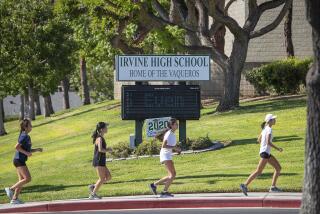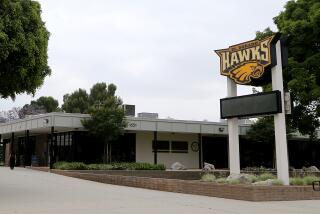Biology Class Rite Hits a Nerve
- Share via
After more than a decade of limiting dissections in science classes to cow eyes, chicken wings and other parts that could be bought at a grocery store, the tony Brentwood School is bringing back the practice whole hog.
Make that, more precisely, whole fetal pig. And whole cat.
For the record:
12:00 a.m. March 16, 2002 FOR THE RECORD
Los Angeles Times Saturday March 16, 2002 Home Edition Main News Part A Page 2 A2 Desk 2 inches; 50 words Type of Material: Correction
Dissection teach-in--A caption incorrectly identified a photograph accompanying a story in Wednesday’s California section on a plan to resume whole-animal dissection in science classes at the private Brentwood School. The photograph showed a teach-in on the subject. The event took place at New Roads School in Santa Monica, not the Brentwood School.
Hoping to boost interest in medical careers, the school has decided to encourage science students to dissect fetal pigs and cats so that they can gain what Brentwood science teachers view as vital hands-on experience.
Though dissection fell out of favor for a time, it is making a comeback in public and private schools and is widely practiced. But at Brentwood, the decision to resume whole-animal dissection has angered some students, who call it cruel and unnecessary.
“Millions of animals a year are killed for this purpose,” said Andrew Oberstein, 14, a ninth-grader.
Given the array of software programs that can teach about animal innards without requiring students to wield scalpels, Oberstein said, “keeping dissection is like being stuck in the Middle Ages.”
Since fall, Oberstein and a classmate, Lindsay Weber, have waged an impassioned campaign to get Brentwood’s new head of school, Michael D. Pratt, to rethink his decree. They recently organized a “teach-in” at the private New Roads School in Santa Monica to discuss the issue and rally support for their cause.
So far, Pratt has listened politely to the students’ concerns but has refused to budge. Dissections have not yet resumed, but teachers said they could begin any time.
“This has historically been an important issue for the school,” Pratt said in an interview at Brentwood, a campus with 673 students in seventh through 12th grades. A recent alumni survey, he said, indicated that a high percentage of former students viewed the absence of dissection as a deficiency in their preparation for college.
When Pratt took over last summer as head of school, science teachers began lobbying to reinstate the practice his predecessor, Hunter Temple, had banned about 12 years ago.
Trained as a historian, Pratt said he dissected just one organism in his life--an earthworm--in 10th-grade biology. He described himself as an animal lover who regularly gives his dachshund the run of his office.
“I have no personal stake in the issue,” Pratt said. Generally, Pratt said, academic departments within schools should make decisions about curricula. He intervened on this issue, he said, because of the ethical dimension.
He said he dutifully read arguments on both sides and listened to faculty and students in private and school meetings. His decision, he said, was “based on the gestalt of the evidence.”
Teri Redman, who teaches ninth-grade biology, said she has tried for years to instruct students about dissection using software simulations.
“It’s not the same at all,” she said. One program, Operation Frog, showed an animated heart beating. “It was all really neat,” she said, “but just a completely different experience.”
Questioned in their classroom, Redman’s students were divided in their opinions. One opponent said her father, a neurologist, told her that practicing dissection didn’t particularly influence his decision to become a doctor.
Others said dissection would be a good learning experience as long as they could be certain the animals had not been abused.
“Assuming we enter college, we don’t want to be at a disadvantage with our peers,” said student Teddy Kim. “In a general sense, all people should agree the human race is superior to all other forms of life.” Dissection can be used, he added, “to promote the health and well-being of the human race.”
Cay Enns, a Brentwood graduate who teaches science and philosophy at the school, said she is excited about the shift.
“I really love cutting into a sheep’s brain,” she said. In its basic structure, a sheep’s brain is almost “identical to a human brain.”
“When I dissected, it made me want to be a surgeon,” she added. “It’s a tactile thing. You can’t replace it.”
The Brentwood science department has assured students that it will buy only animals or animal parts that are byproducts of the meat industry or euthanized by the Humane Society. All purchases will be made from supply houses supervised by the U.S. Department of Agriculture. Fetal pigs will be used in ninth-grade biology, with cats reserved for advanced science classes.
An informal survey by the Brentwood teachers found that most other independent schools in the area encourage whole-animal dissection. A few schools steer clear, however.
At Crossroads School for Arts and Sciences in Santa Monica, the science department head uses only animal parts in his anatomy and physiology classes. And he gets grief even for that from an animal rights club on campus. He said he sees the students’ point.
“Biology is the study of life,” teacher Michael Sommers said. “It’s kind of incongruous to say, ‘Let’s kill this and dissect it.’”
California’s education code, which governs public schools, states that any pupils who have a moral objection to dissection may choose not to participate without fear of having their grades suffer, said Phil Lafontaine, a consultant with the California Department of Education.
“Our mantra is that the kid has the right [to opt out] and the school district should have an alternative available, rather than leave the teacher hanging,” he said.
Mike Grasso, the science department chairman at Brentwood, said no student will be forced to dissect.
Such assurances do not sway Oberstein and Weber. At the teach-in--which attracted about 50 adults and students--Weber recalled how her dream of becoming a doctor almost died when her sixth-grade class dissected frogs. When the teacher went out for coffee, she said, pupils began slashing off frog limbs and throwing them at one another.
“The memory has haunted me ever since,” she said. She still plans to pursue a career in medicine, she said, adding: “I hope to be up here talking about how I became a doctor without having to dissect.”
Jerry W. Vlasak, a trauma surgeon and advisor to the Physicians Committee for Responsible Medicine, a health advocacy organization, said he went through college and medical school without dissecting any animals.
“No surgeon in this country learns how to be a surgeon by dissecting animals,” he told the teach-in participants. “We learn everything we need on humans.”
As is often the case in such highly charged debates, few people changed their views about dissection at the teach-in.
But it pleased Oberstein that Redman, his teacher, was so impressed by some of the 3-D software that she plans to set up a demonstration for Brentwood’s science faculty. Oberstein hopes that software programs could enable the school to use fewer animals.
More to Read
Sign up for Essential California
The most important California stories and recommendations in your inbox every morning.
You may occasionally receive promotional content from the Los Angeles Times.














